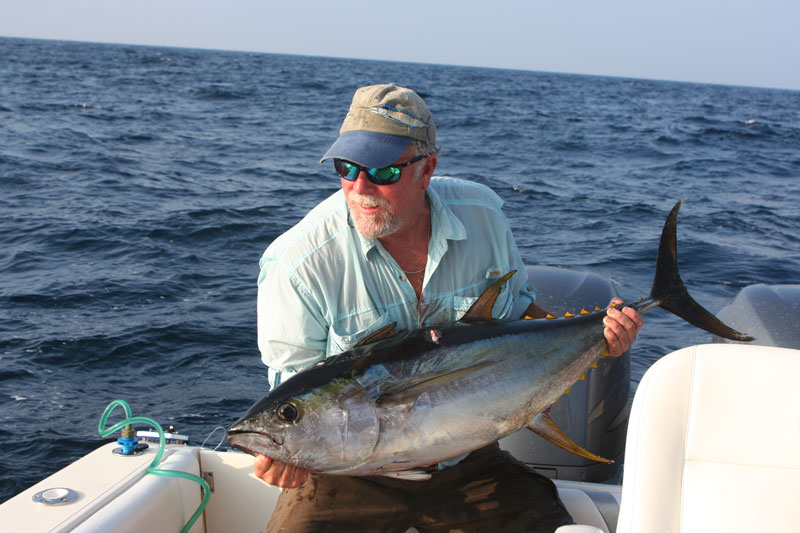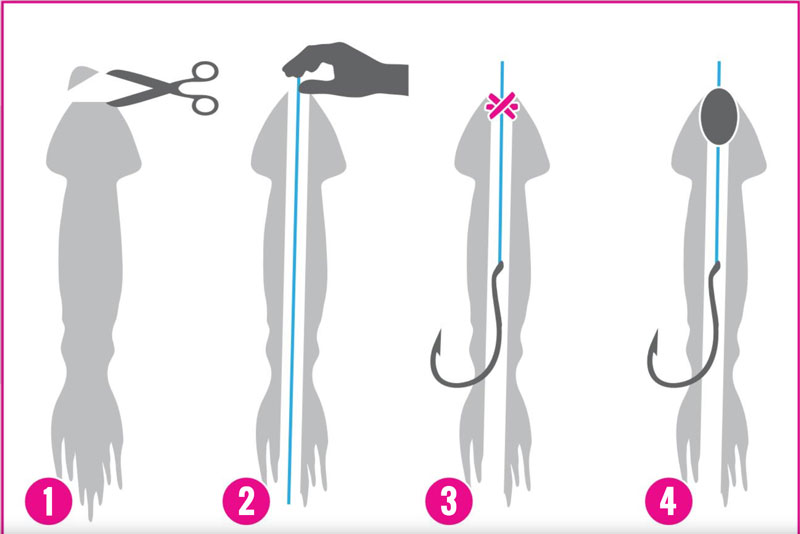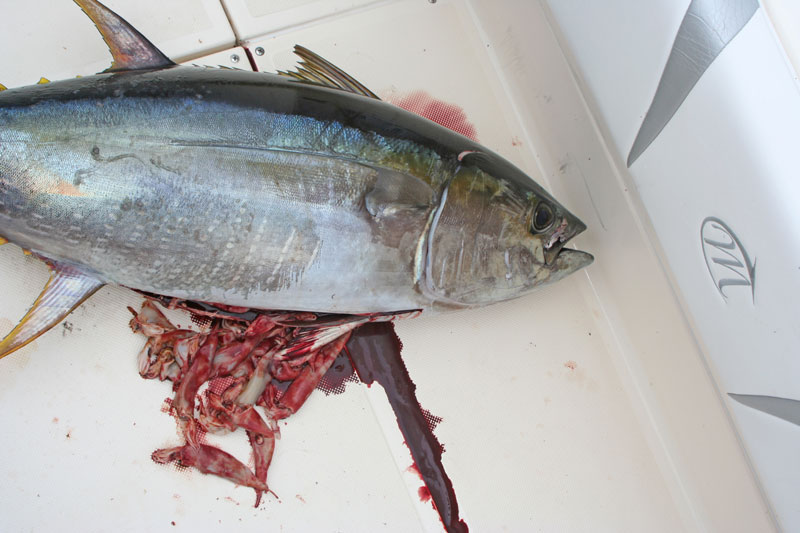You say you like fish like yellowfin tuna, which pull hard, fight even after they're caught, and when sizzling on the grill will make every neighbor within sniffing distance jealous to the core? The tactics you’ll use can differ by location and time of year, but regardless of the specifics, learning and using a rigged squid will help you bring more tuna to the gaff in the long run — because this is a bait that turns fishless days into homerun hits.

Tempting Tentacles
Squid are probably the most under-utilized tuna bait in the Mid-Atlantic region. This is a bit odd, since squid make up a huge part of the tuna’s diet. According to multiple stomach contents studies up to 42-percent of a tuna’s diet may be comprised of squid. And, most tuna have to eat around 15 percent of their body weight per day to stay healthy and satisfied. In other words, they chow down on one heck of a lot of squid. Anglers in other areas depend on them for bait, but many of us in these here parts fall victim to habit. We pull ballyhoo when we try trolling and we bait up with butterfish when we go chunking for tuna because… well, we always have and that’s what everyone does.
A rigged squid has saved the day for me more than once or twice or 10 times. Not the big giant rigged squid you see frozen in the tackle shop freezer, either. Most of the squid living in our zone are just eight or 10 inches long and the hatch-matching boxed squid sold for flounder bait are highly effective for catching tunas, maybe more so than those Humboldt-like, vacuum-packed products.
Rigging Squid
Whether chunking or trolling, these succulent little cephalopods can be rigged up in a very similar way. First, use a pair of scissors to snip off the tip of the mantle. The mantle is hollow so you don’t need to clip away much, just a chunk the size of a match head, creating a hole at the top wide enough for your leader. Then take the leader, push it through the hole, and continue to push to work it down through the hollow mantle. If it grabs the meat and starts digging in, back it out, spin the line between your fingers a bit, then start pushing again. Keep going until the end of the leader comes out the bottom of the mantle and is hanging next to the tentacles. Then tie or crimp on a hook, as leader size dictates.

Chunk Change
If you’re chunking, pull through enough additional line to match the mantle’s length. Then bend a rubber band around the line. The idea here is to stop the squid from sliding down the line when the rubber band hits the hole at the top of the mantle. If you judged the length properly, the tip of the mantle will hang up on the rubber band and your hook will be dangling just below the mantle, amongst the tentacles.
Strip it back as you would a butterfish chunk, and the Squidly will often disappear down a gullet. But you also get an added bonus: after stripping back if you engage the reel and leave the rod in the holder, the squid’s tentacles will wave enticingly in the current. Unlike a butterfish chunk, which doesn’t get hit very often if it’s just sitting there being ignored, the Squidly still looks alive and draws strikes.
Trolling with Rigged Squid
When trolling, there’s one change to the rig: before attaching the hook slide an egg sinker onto the leader (see step IV above). A half-ounce is usually enough, but if you’re trolling on the fast side or it’s really rough out, going to one ounce is a good move.
Mr. Squidly should be trolled on a light drag so you hear the clicks if there’s any kind of take, because if the squid gets hit but the fish misses the hook, your bait will be trashed. If you set the drag set to strike, unless you happen to see the rod tip bob, you may never know there was a hit.
When trolling there’s a good chance you can up the leader size as opposed to chunking, but I’ll generally cap it at 80 and often pull 60 (fluorocarbon). Thicker leaders are tougher to work down the mantle, and require crimping. Lighter leaders are generally easier to deal with and the hook can quickly be tied right on.

Problems with the Cephalopods
Wait a sec — if the Squidly works so good, why don’t the pros always use ‘em? There are several downsides to rigging and running this bait. First off, it’s time intensive. Every time you catch a fish or miss a strike, the hook has to be cut off the leader and you have to start all over again, and getting the leader to pass through the squid can be problematic, eating up more time. Second, as mentioned earlier, missed strikes mean trashed baits, period. If you’re not careful about things you can drag a bare hook or an unappealing squid-ball through the ocean for hours on end without realizing it. And third, when trolled a Squidly is good for maybe one hour. Maybe. They aren’t nearly as robust as ballyhoo, and disintegrate over time.
Despite those downsides (plus the fact that now you have to buy a box of squid on top of everything else) I never leave the dock unprepared to deploy the Squidly. Ever. When chunking, you’ll find that more than half the time it draws noticeably more strikes than butterfish chunks do, even in a butterfish slick. And when trolling, this is the bait that works when nothing else seems to. It’s the day-saver.
Plus, worst case scenario: you can make calamari for dinner.
Editor's note: if you're overnighting at the canyons be sure to bring some squid jigs and catch your own fresh squid. See how in How to Catch Squid While Fishing Offshore.